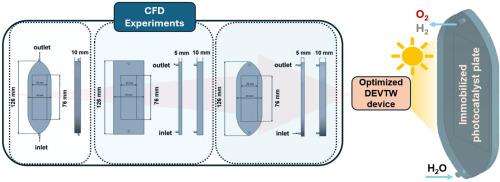Development and optimization of a device for testing photocatalysts in continuous flow regime
IF 3.9
3区 工程技术
Q3 ENERGY & FUELS
Chemical Engineering and Processing - Process Intensification
Pub Date : 2025-10-13
DOI:10.1016/j.cep.2025.110596
引用次数: 0
Abstract
This work combines computational fluid dynamics (CFD) simulations with experimental validation to optimize a photocatalytic reactor for oxygen (O2) production. By addressing key chemical diffusion limitations in heterogeneous photocatalysis, the study aims to optimize reactor geometry and enhance its performance. CFD simulations were employed to assess the performance of three devices (DEVAW, DEVTR, and DEVTW) with different shapes and depths under similar operational conditions. Three-dimensional (3D) CFD simulations were conducted to analyze the hydrodynamic behavior and the Residence Time Distribution (RTD) at a flow rate of 10 cm3 min-1. Results demonstrate that the DEVTW reactor, at a height of 5 mm, achieved superior molar fluxes and a higher O2 concentration of 158 µM, compared with the DEVAW and DEVTR reactors of the same height, which reached 140 µM and 144 µM, respectively. The superior O2 concentration is attributed to the increased velocity gradient near the catalytic plate, which facilitates mass transfer by improving convective transport of O2 from the catalyst surface and promotes the diffusion of O2 molecules. Mass transfer CFD simulations further indicate that the chemical reaction is the rate-limiting step, revealing that the DEVTW device is adequate for efficient photocatalyst screening in dissolved O2 evolution reactions.

光催化剂连续流测试装置的研制与优化
这项工作结合了计算流体动力学(CFD)模拟和实验验证,以优化光催化反应器的氧气(O2)生产。通过解决多相光催化中关键的化学扩散限制,该研究旨在优化反应器的几何形状并提高其性能。采用CFD模拟方法,对DEVAW、DEVTR和DEVTW三种不同形状和深度的设备在相似工况下的性能进行了评估。采用三维(3D) CFD模拟分析了10 cm3 min-1流速下的流体力学行为和停留时间分布(RTD)。结果表明,DEVTW反应器在5 mm高度时,其摩尔通量和O2浓度均优于DEVAW和DEVTR反应器(分别为140µM和144µM), O2浓度为158µM。优越的O2浓度是由于催化板附近的速度梯度增大,从而通过提高O2从催化剂表面的对流运输来促进传质,促进O2分子的扩散。传质CFD模拟进一步表明,该化学反应是限速步骤,表明DEVTW装置足以在溶解O2析出反应中进行有效的光催化剂筛选。
本文章由计算机程序翻译,如有差异,请以英文原文为准。
求助全文
约1分钟内获得全文
求助全文
来源期刊
CiteScore
7.80
自引率
9.30%
发文量
408
审稿时长
49 days
期刊介绍:
Chemical Engineering and Processing: Process Intensification is intended for practicing researchers in industry and academia, working in the field of Process Engineering and related to the subject of Process Intensification.Articles published in the Journal demonstrate how novel discoveries, developments and theories in the field of Process Engineering and in particular Process Intensification may be used for analysis and design of innovative equipment and processing methods with substantially improved sustainability, efficiency and environmental performance.

 求助内容:
求助内容: 应助结果提醒方式:
应助结果提醒方式:


